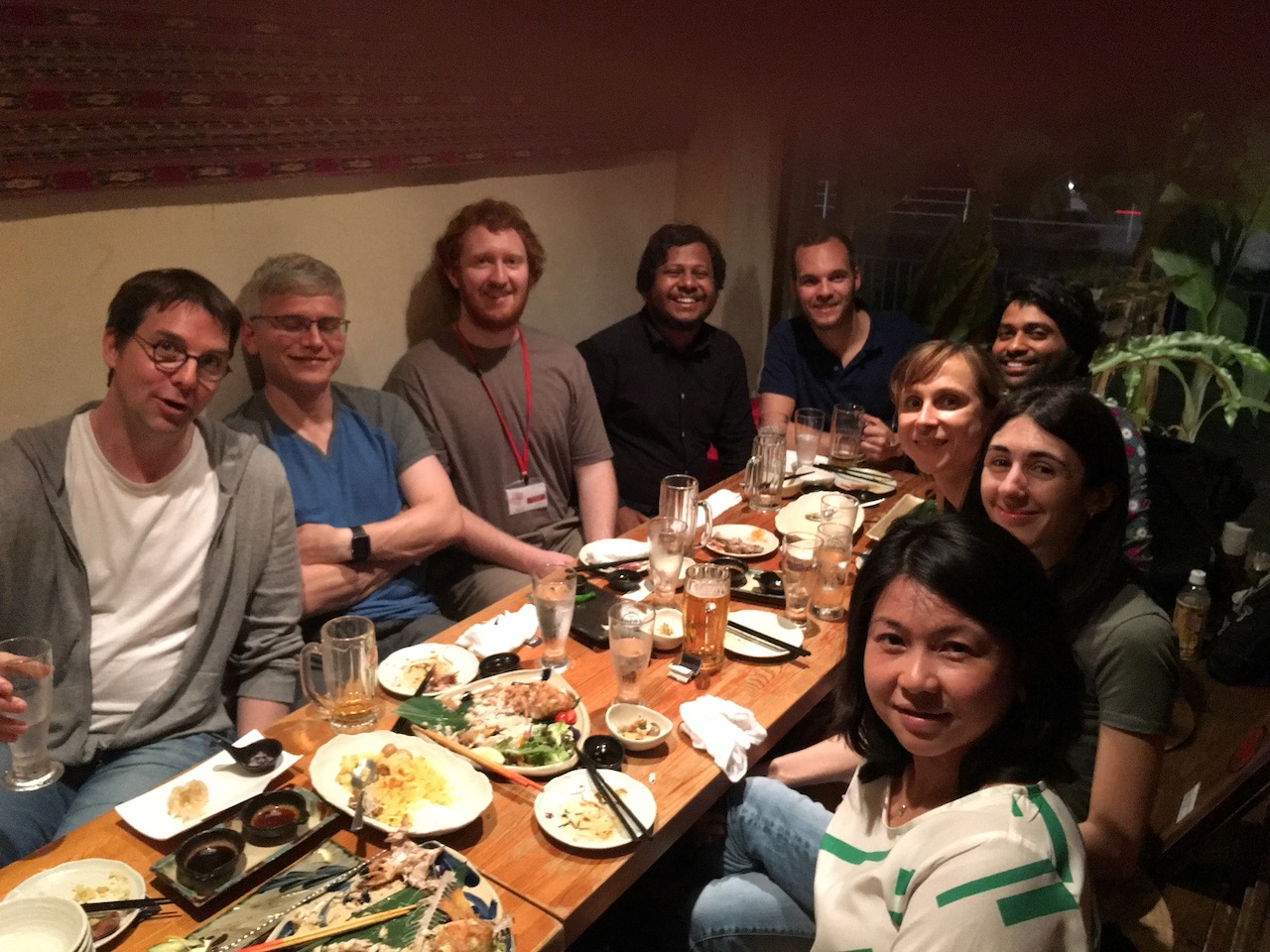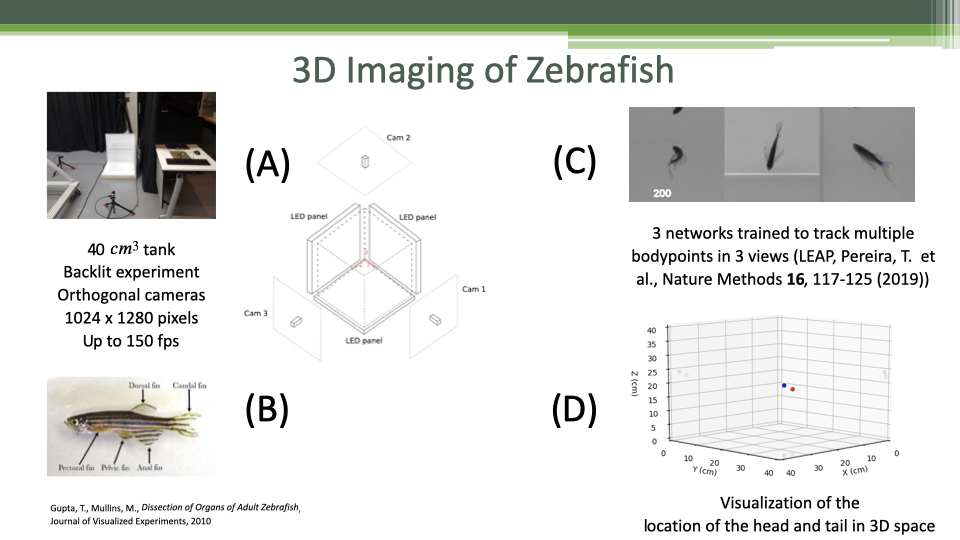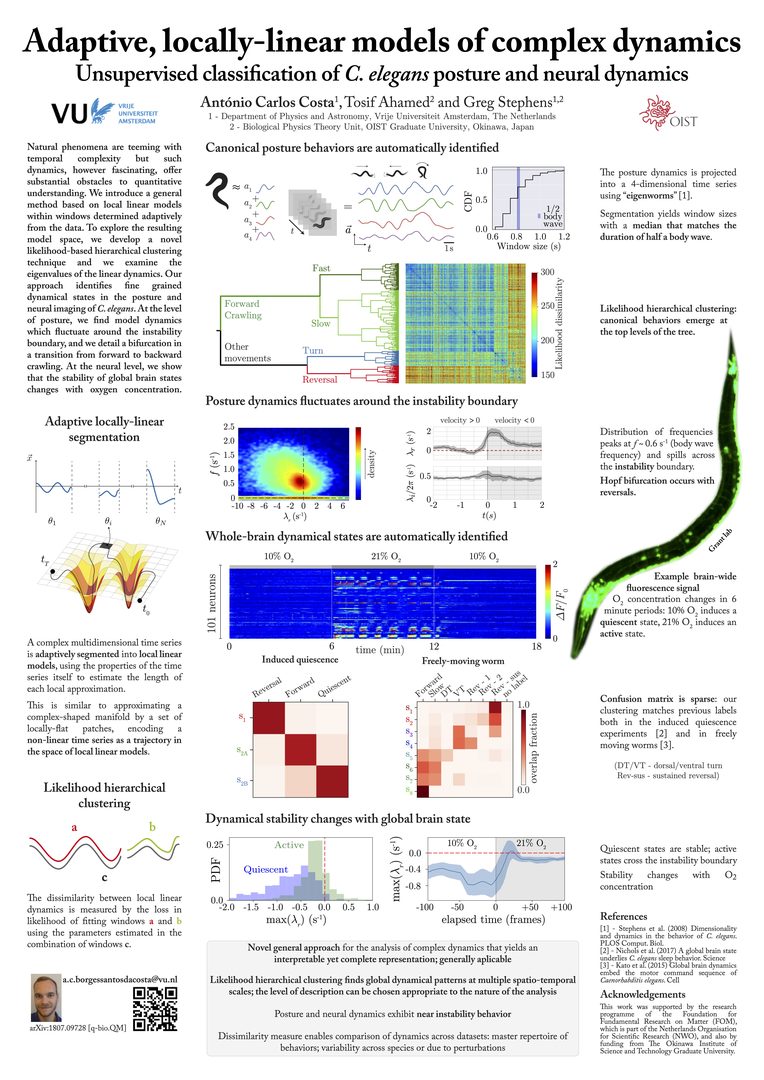FY2018 Annual Report
Biological Physics Theory Unit
Professor Greg J Stephens

Abstract
The Stephens Group is pioneering a new field – the physics of behavior: from individual organisms to entire societies. The science of the living world is overwhelmingly focused on the microscopic: the structure of DNA, the machinery of cells that can convert energy and transports materials, or the pattern of electrical activity in our brains from which thoughts arise. Yet, all of these processes serve the greater evolutionary goals of the organism: to find food, avoid predators and reproduce. This is the behavioral scale, and despite it’s importance, our quantitative understanding of behavior is much less advanced. But how do we quantify the emergent dynamics of entire organisms? What principles characterize living movement? Research in our group addresses these fundamental questions with a modern biophysics approach and model systems ranging from the nematode C. elegans to zebrafish and honeybee collectives. We combine theoretical ideas from statistical physics, information theory and dynamical systems and work in close collaboration with scientists from OIST and around the world to develop and analyze novel, quantitative experiments of organisms in natural motion.
1. Staff
- Prof. Greg J. Stephens
- Ms. Naoko Ogura-Gayler, Research Administrator
- Dr. Kasia Bozek, Group Leader
- Ms. Laetitia Hebert, Software Engineer
- Mr. Tatsuo Izawa, Technicican
- Mr. Yoann Portugal, Technician (from Jan 2019)
- Mr. Tosif Ahamed, PhD Student
- Mr. Liam O'Shaughnessy, Visiting Research Student
- Mr. Antonio Carlos Costa, Visiting Research Student
- Mr. Xavi Fernandez-Luengo Flores, Research Intern
2. Collaborations
2.1 Human Frontiers Science Program
- Description: The physics of social behavior in the 3-dimensional shoaling of zebrafish, Danio rerio
- Type of collaboration: Joint research
- Researchers:
- Professor Ichiro Masai, OIST Graduate University, Okinawa JP
- Professor Joshua Shaevitz, Princeton University, Princeton USA
2.2 Information Processing in Living Systems
- Description: Theoretical Biophysics of Optimal Sensing
- Type of collaboration: Joint research
- Researchers:
- Dr. Vudiwat Ngampruetikorn, Northwestern University, Evanston USA
3. Activities and Findings
3.1 Research Findings and Activities
In FY2018 the Biological Physics Theory group continued to advance in methodolgical development for the high-resolution posture-scale 3D tracking of multiple zebrafish (Figure 1) and in building markerless detection and tracking techniques to capture the individual dynamics of every bee in a large colony (Figure 2). Theoretical and computational work on understanding complex dynamics, with a focus on approaches rooted in dynamical systems and statistical physics, resulted in the publication (including assoicated data and code) of an interpretable yet powerful locally-linear model (Figure 3).

Figure 1: We contiue to progreess in constructing an imaging system and computational pipeline for the 3D bodypoint tracking of zebrafish.

Figure 2: Our first published results using deep learning for dense object detection (Bozek et al, CVPR 2018). We aim for the markerless tracking of an entire insect colony at high temporal resolution.

Figure 3: Our approach for analyzing complex, multidimensional time series using interpretable, locally-linear models applies across a wide variety of systems, from the motor behavior of C. elegans to neural dynamics and more (Costa et al, PNAS 2019).
3.2 Professional Activities
GJ Stephens, Co-organizer, Physics of Behavior: Movement, Control, and Learning, Aspen Center for Physics, USA May 27-June 17 (2018)
GJ Stephens, Co-director, Cajal Course in Behavior of Neural Systems, Lisbon, Portugal July 15-Aug 4 (2018)
3.3 PhD Dissertations
Ray Xin Lee (Supervisor: Bernd Kuhn; Co-supervisor: GJ Stephens; Mentor: Mukhles Sowwan)
Thesis Title: Nature and source of animal spontaneous behaviors: Insights from psychobehavioral development and neuronal population dynamics in mice
OIST Graduate University http://doi.org/10.15102/1394.00000700
Hiroaki Hamada (Supervisor: Kenji Doya; Co-supervisor: GJ Stephens)
Thesis Title: Serotonergic Control of Brain-Wide Dynamics
OIST Graduate University
4. Publications
4.1 Journals and Preprints
- A Carlos Costa, T Ahamed & GJ Stephens, Adaptive, locally-linear models of complex dynamics. Proc Nat Acad Sci (USA) 107, 14425–14430 (2019); arXiv:1807.09728 [q-bio.QM].
- K Bozek, L Hebert, AS Mikheyev & GJ Stephens, Pixel personality for dense object tracking in a 2D honeybee hive. (2018); arXiv:1812.11797 [cs.CV].
- RX Lee, GJ Stephens & B Kuhn, Affective bonding explains post-traumatic behavioral development in adult mice. (2018); bioRxiv:249870.
- K Bozek, L Hebert, AS Mikheyev & GJ Stephens, Towards dense object tracking in a 2D honey- bee hive. IEEE/CVF Conference on Computer Vision and Pattern Recognition 4185–4193. (2018); doi:10.1109/CVPR.2018.00440; arXiv:1712.08324[cs.CV]
4.2 Books and other one-time publications
Nothing to report
4.3 Oral and Poster Presentations
- GJ Stephens, American Physical Society Meeting Session R51: Artificial Intelligence, Data, and Dynamics: Learning Physical Models of Living Systems, Boston US (Mar 2019)
- Kasia Bozek, Max-Delbrück Center for Molecular Medicine, Berlin DE (Nov 2018)
- GJ Stephens, University of Konstanz, Konstanz DE (Nov 2018)
- GJ Stephens, Informatics Seminar, University of Sussex, Brighton UK (Nov 2018)
- GJ Stephens, OIST Faculty Lunch (Oct, 2018)
- GJ Stephens, Banbury Meeting on Quantitative Approaches to Naturalistic Behaviors, Cold Spring Harbor US (Sep 2018)
- A Costa*, T Ahamed & GJ Stephens, Physics of Living Matter XIII, Marseille FR (Sep 2018)
- GJ Stephens, FENS Forum on Using Computational Neuroethology to Dissect the Neural Basis of Behavior, Berlin DE (Jul 2018)
- GJ Stephens, OIST Computational Neuroscience Course, Okinawa Japan (Jun 2018)
- GJ Stephens Physics colloquium, University of Oregon, Eugene US (Jun, 2018)
- K Bozek*, L Hebert, AS Mikheyev & GJ Stephens, Conference on Computer Vision and Pattern Recognition (CVPR), Salt Lake City, US (Jun, 2018)
5. Intellectual Property Rights and Other Specific Achievements
Nothing to report
6. Meetings and Events
Seminar
6.1 Mapping the Structure of Animal Behavior
- Date: Dec 17, 2018
- Venue: OIST Campus Lab 1
- Speaker: Prof. Gordon Berman, Emory University
6.2 Evolutionary predictions from biophysical models by Prof. Michael Laessig, University of Cologne
- Date: July 15, 2018
- Venue: OIST Center Building
- Speaker: Prof. Michael Laessig, University of Cologne
Meeting at OIST
- Date: November, 2018
- Venue: OIST Lab 2
- Speaker: Prof. Joshua W. Shaevitz, Princeton University
Meetings, Travel
- Physics of Behavior: Movement, Control, and Learning, Aspen Center for Physics, Aspen USA (Jun 2018)
- 13th International Zebrafish Conference, Madison USA (Jun 2018)
- Meeting with Prof. Tim Landgraf, Freie Universitat Berlin, Berlin DE (Nov 2018)
- Meeting with Prof. Ben de Bivort, Harvard University, Cambridge USA (Mar 2018)
7. Other
Nothing to report.



